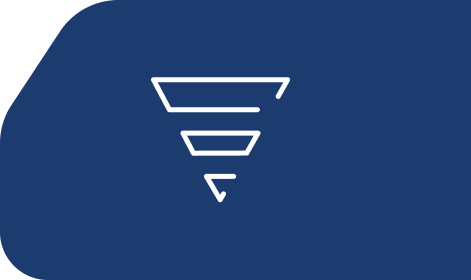Competitive Displacement: How to Win Market Share by Increasing Discoverability
15 min

Executive summary
This guide outlines four actionable strategies for winning market share through competitive displacement, focusing on understanding competitor weaknesses and aligning your brand’s demand generation strategies to address unmet client needs.
Three-quarters of buyers prefer a sales rep-free experience, making increasing your organization’s discoverability a critical part of this strategy to ensure buyers discover your brand during their research.

Best practices include:
This article provides a framework for client-centric demand marketing that enables stronger positioning, conversion, and long-term growth.
Winning market share with demand generation: A playbook for competitive displacement
The B2B buyer's journey is constantly evolving. According to the 6sense B2B Buyer Experience Report, 70% of buyers prefer to contact vendors directly when they are ready to buy, rather than interacting with sales early in their journey.
This is a result of the growing complexity of the B2B buying process and the greater accessibility of information, with buyers favoring self-service research.
Understanding and adapting to the changing behavior of B2B buyers, and investing in discoverability through competitive displacement strategies, are essential to outpace competitors and capture market share.
In this article, we share a playbook for aligning your demand generation efforts with unmet buyer needs to increase visibility, convert competitor clients, and win more market share.
What is competitive displacement?
Competitive displacement refers to strategies designed to motivate potential or current competitor clients to switch to another brand’s products or solutions. Successful competitive displacement efforts enhance market positioning and secure a larger market share.
Competitive displacement is a common goal in highly competitive markets and is often a core element of growth strategies. The outcomes from displacement strategies can also serve as an indicator of an organization’s ability to create innovative, accurate, and compelling offers to attract new audiences and break into new markets.
What is market share?
Market share refers to an organization’s sales as a percentage of the total sales for its industry, often over a fixed time period. Market share is not only an indicator of competitive positioning, but also the performance and success of the broader strategies being implemented.
As a result, increasing market share is a key goal for organizations looking to consistently drive their growth in comparison with their competitors.
The importance of client-centricity
According to Forrester’s Customer Experience Benchmark Survey (2024), only 3% of organizations are currently “client-obsessed” and put their clients’ needs front and center. As a result, many competitors could be missing out on key buyer behavioral changes, such as a growing risk aversion, increase in buying group size, and prioritization of efficiency.
This creates a clear opportunity to deliver the experiences today's buyers are seeking and capture competitive ground.
Client-centricity is an important pillar of demand generation that prioritizes buyer enablement and nurturing independent buyers with content to aid their research, improving discoverability early on.
Focusing on understanding and addressing potential clients' needs, preferences, and pain points improves the performance of your nurturing strategy and increases the likelihood of winning their business, especially when there are gaps in your competitors' service.
Why demand generation is essential for competitive displacement

Prioritizing full funnel demand generation, built on a strong brand identity and Unique Value Proposition (UVP), is essential for gaining a competitive advantage.
The goal is to shift client interest to your brand through an ongoing omnichannel demand marketing strategy that aligns with their needs and pain points as they progress through the buying journey.
Below is an example of how demand generation supports the buyer journey and competitive displacement strategies:
Funnel stage
Buyer objective
How demand generation supports
Role in competitive displacement
TOFU
Identify and
solve a problem
- Run SEO and AEO content
- Paid search and social campaigns that target pain-point keywords
- Produce content addressing gaps competitors ignore
MOFU
Craft a vendor shortlist comparing solutions
- Offer whitepapers, case studies,
and comparison guides showing competitive advantages - Use retargeting to maintain
interest
by demonstrating how your solution better
meets their unique needs
BOFU
Select the right solution
exclusive offers to support decision making
BOFU
Obtain continuous value
- Provide onboarding content, educational emails, and client success webinars
- Highlight innovation roadmap
4 competitive displacement strategies to increase your market share

1. Collect demand intelligence
Competitive displacement campaigns depend on the relevance and quality of your messaging and should therefore be backed by actionable demand intelligence.
Currently, only 8% of marketers utilize advanced buyer and account intelligence models to shape their sales and marketing efforts (Voice of the Marketer, 2025).
Sources of information to gain insights into the specific needs that potential buyers at competitor accounts are trying to address include:
- Competitor websites: Case studies, testimonials, and content will often share vital information on client portfolios
- Client sites: Client sites and communications are often packed with key information; some may be identifiable using tools such as Install Base
- CRM: A CRM may contain previous lost opportunities with your team that can be reevaluated
- Review sites: Leverage reviews on sites such as G2, which provide detailed information on buyers and users, as well as their challenges and opportunities
- Intent data: Use historical and current third-party intent data to observe which products, messages, and strengths resonate with the market
- Sentiment analysis: Gauge client sentiment by analyzing social interactions on user groups, corporate accounts, and client success accounts
Important:
Prioritize first and zero party party data where possible to ensure compliance with privacy regulations and to maintain ethical demand practices.
As you go through the process of analyzing the information you have gathered, structure your findings in the form of a SWOT analysis to guide your strategy:
Strengths:
- How does your competitor exceed client expectations?
- What is your competitor’s Unique Value Proposition (UVP)?
- What leads clients to ultimately choose your competitors?
Weaknesses:
- What are common pain points that competitor clients have with their solutions?
- What problems have clients reported?
- What gaps do competitors have in the products or services they offer?
Opportunities:
- Are your competitors doing anything that presents an opportunity for your organization?
- Have your competitors stopped promoting any products?
- Have your competitors changed any of their service models?
Threats:
- Is your competition doing anything that presents a threat to your organization?
- Have your competitors lowered their prices recently?
- Are your competitors offering new products or services, or entering new markets?
2. Create content that spans the buying journey
Once areas of friction and instances where competitor client needs are not being met have been identified, they can be used to inform your content strategy.
Below is an example of a content strategy that spans the buyer’s journey and shows the role that specific content can play in competitive displacement:
Stage in buying journey
Demand strategy
Content examples
Recommended channels
Awareness
- Addressing concerns
- Establishing interest
- Highlighting competitor gaps
- Brand positioning
- Articles and thought leadership targeting unmet needs
- Engaging social media posts
- Search-based marketing (SEO, paid search)
- Social media
- Email nurture sequences
Consideration
- Addressing pain points
- Establish brand value
- Building buyer
confidence - Reinforcing your differentiators
- Comparison pages
- Case studies or solution briefs
- Website blogs and whitepapers
- Social media
Consideration
- Addressing implementation concerns
- De-risking your solution
- Showcasing technical value
- Webinars or podcasts on UVPs
- Integration/specification sheets
- Webinars
- Personal outreach
(LinkedIn/email)
Consideration
- Building strong business cases
- Executing displacement campaigns
- Converting interest to intent
- ROI calculators
- Free demo or trial offer
- Personal outreach
- Landing pages tied to
paid search
Consideration
- Framing business value
- Leveraging third-party validation
- Mitigating risk
- Awards and recognitions
- Client reviews
- Review sites
- Email newsletters
- Webinars
Decision
- Establishing brand expertise
- Increasing internal advocacy
- Building consensus
- Client testimonials
- Industry use cases
- Webinars
- Social media
- Industry events
By orchestrating displacement content across your channel mix, you can ensure that your brand is top-of-mind for competitor clients. This ultimately drives awareness and preference for your brand above others, increasing your market share.
3. Cement your value over competitors
Utilizing your demand intelligence, highlight what unique pain points, challenges, and unique selling points (USPs) your brand offers that competitors do not.
Communicating what sets you apart is crucial for securing a strong market position that is difficult for competitors to challenge. Bolster this with track record, awards and accolades, and testimonials that reinforce your authority.
Buyers are more likely to switch to a brand they perceive as reliable, trustworthy, and that provides continuous value. Not only does this reduce risk from purchase decisions, but it also highlights the weaknesses of competitors, including current providers.
Below are a few best practices for reinforcing your brand value:
- Incorporate your UVP into your messaging: Your UVP should be at the heart of your brand's communication, consistently highlighted in every touchpoint, from taglines and social media content to email marketing
- Develop and leverage a clear and consistent brand story: Frame what your brand stands for and the unique value you provide to clients into a narrative that appears consistently across all platforms
- Link to and share client testimonials and reviews: Ensure your reviews and testimonials appear prominently on your website, social media, and other touchpoints (such as email signatures)
- Highlight awards and industry recognition: Display awards prominently on your website, especially on the homepage, “About Us” section, or on a dedicated “Awards and Recognition” page
- Share thought leadership articles: Publish thought leadership articles authored by your organization’s leaders on your website, reputable third parties, and across your social media.
Strong brand value also presents a perception of quality. That is why it is of utmost importance to continuously build on your processes to ensure continued excellence and accuracy.
4. Iterative processes and assessments
Supporting demand performance with an iterative process means continuously refining each aspect of your demand generation strategy, such as data collection, analysis, content creation, and execution, based on ongoing feedback, performance metrics, and evolving market conditions.
Below are examples of review processes and recommended cadences to improve your demand strategy:
Demand strategy
Cadence
Performance metric
Refinement process
Data collection and analysis
Quarterly
- Competitor analysis
- Competitive benchmarking
- Market positioning review
opportunities
Content creation
Monthly
- Analytics reporting
- Trend analysis
Optimization
Monthly
- Campaign performance reporting
- Channel review
Investing time into an ongoing competitive displacement strategy will not only help your organization secure a greater percentage of market share but also provide the most current intelligence needed to inform your sales and marketing activities.
Key takeaways

Here are the essential insights to help you displace competitors and increase market share for your organization:
- Knowing your competitor's clients is more important than knowing your competitor. Identify what your competitor’s clients value about their experience, as well as any points of friction that can be addressed by your solution
- Client-centricity is critical for swaying competitor clients in your direction. Prioritize client needs in every strategic decision to drive sustainable demand and engagement
- A strong brand identity is crucial for increasing visibility and building authority. Buyers are more likely to switch to a brand they perceive as reliable
- Utilize demand intelligence to improve brand awareness and client engagement. Use data from CRM systems, intent platforms, review sites, and competitors to identify client needs and gaps
- Innovate often and update your competitive displacement strategies regularly to enable refinements that address evolving client needs and market conditions












